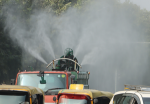Jan 6, 2019
London:The Greenland ice sheet emits tons of methane according to a new study, showing that subglacial biological activity impacts the atmosphere far more than previously thought, say researchers.
The study, led by a team from the University of Bristol in the UK, reported that ice sheet beds, which hold large reserves of carbon, liquid water, microorganisms and very little oxygen — the ideal conditions for creating methane gas — are also atmospheric methane sources.
Using novel sensors to measure methane in meltwater runoff in real time, they observed that methane was continuously exported from beneath the ice.
They calculated that at least six tons of methane was transported to their measuring site from this portion of the Ice Sheet alone, roughly the equivalent of the methane released by up to 100 cows.
While some methane had been detected previously in Greenland ice cores and in an Antarctic Subglacial Lake, this is the first time that meltwaters produced in spring and summer in large ice sheet catchments have been reported to continuously flush out methane from the ice sheet bed to the atmosphere, the researchers said.
“What is also striking is the fact that we’ve found unequivocal evidence of a widespread subglacial microbial system. Whilst we knew that methane-producing microbes likely were important in subglacial environments, how important and widespread they truly were was debatable,” explained lead researcher Guillaume Lamarche-Gagnon, from the varsity.
“Now we clearly see that active micro-organisms, living under kilometres of ice, are not only surviving, but likely impacting other parts of the Earth system. This subglacial methane is essentially a biomarker for life in these isolated habitats,” Lamarche-Gagnon added, in the paper reported in the journal Nature.
Methane gas (CH4) is the third most important greenhouse gas in the atmosphere after water vapour and carbon dioxide (CO2). Although, present in lower concentrations than CO2, methane is approximately 20-28 times more potent.
Lamarche-Gagnon said: “Several orders of magnitude more methane has been hypothesized to be capped beneath the Antarctic Ice Sheet than beneath Arctic ice-masses. Like we did in Greenland, it’s time to put more robust numbers on the theory.”



















